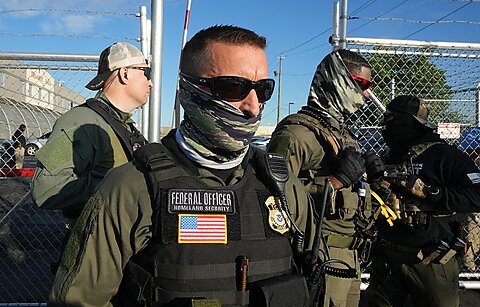
Walter Olson
ICE, our new secret police agency, claims its agents must wear masks and conceal their identities because of a rising risk of violence on the job or home terror attacks. But according to columnist Philip Bump at the Washington Post, ICE refuses to substantiate those claims—and there’s much reason to doubt them.
The agency does not publish statistics on assaults suffered by its agents, and because it has a habit of characterizing behavior like that of New York City Comptroller Brad Lander the other day as “assault” (Lander linked arms with a man being arrested and was in turn arrested), it’s not clear how dependent on definition its internal numbers may be. Meanwhile, the related but more transparent Customs and Border Protection agency does publicly release statistics on what it classifies as assaults on its agents. Those assaults have been declining since 2022 and are down again in 2025.
ICE’s press releases indicate that most violence occurs during detentions, and as Bump notes, it’s not clear why hiding identities would do anything to prevent that category of violence. “ICE didn’t provide me with any examples of immigration officers being identified, targeted, and assaulted outside of the context of an arrest.”
A reader alerted me to the fact that even if ICE does not publish injury statistics, it does publish a page saluting officers who have died in the line of duty. The page lists 19 officers who’ve died over the past five years. Of those 19 deaths, 15 list the cause as COVID-19, and three list it as cancer associated with the Ground Zero terrorist attacks of September 11, 2001. Only one of the 19 was a death of violence, caused by the accidental discharge of the officer’s service-issued weapon.
Homeland Security Secretary Kristi Noem, Attorney General Pam Bondi, and other officials are asking us to get used to the idea of a disguised and, for that reason, doubtfully accountable secret police force, at odds with the American policing practices of the past century, because of disturbing hypotheticals about home terror attacks that might someday occur. Meanwhile, judges, elected lawmakers, and others continue to do their jobs in public each day in America despite very real home terror attacks that have already occurred.
At The Bulwark, the editorialists make an interesting point about how this administration’s refusal to respect process rights for persons once detained tends to exacerbate the tensions that arise during the act of detention itself:
There’s [a] way in which ICE’s lawlessness has incentivized Good Samaritans to resist their enforcement efforts. Think of how ICE arrests used to go. Agents show up to take a person into custody. They may be in uniform or in plainclothes, but their faces are visible and they show their badges when asked. The person they’re arresting knows he’ll have the opportunity to speak to a lawyer, to tell his family where he’s being held, and to plead his case before a judge.
Now snap back to the present day and put yourself in Lander’s shoes. Masked agents show up to whisk a migrant away. Maybe he’ll get to tell his family where he is, maybe he won’t. Maybe he’ll have the opportunity to speak to a lawyer or plead his case to a judge, maybe he won’t. And you think to yourself: Will there be a legal process? Or am I the very last person who has a chance to intervene on this person’s behalf?
(Cross-posted and expanded from the author’s Substack.)






